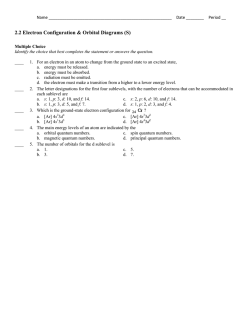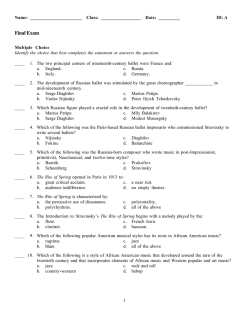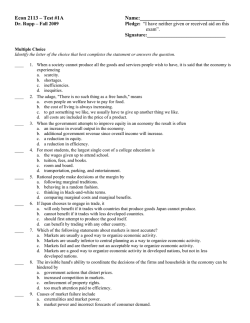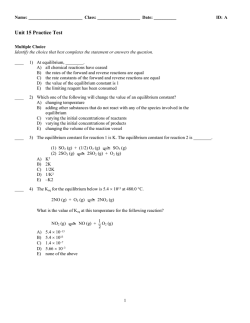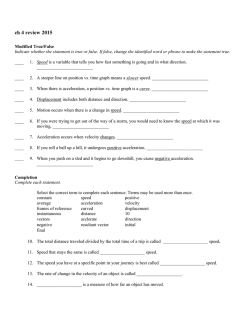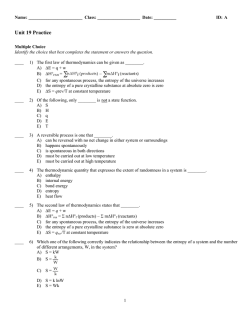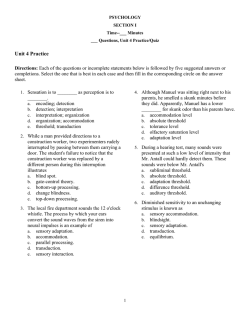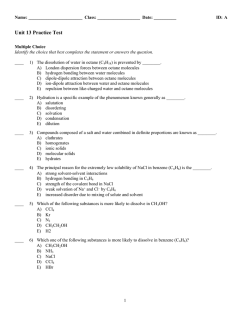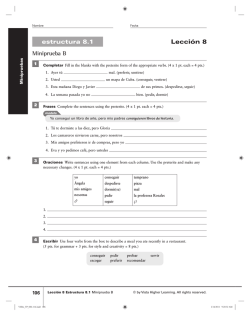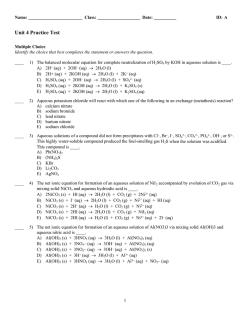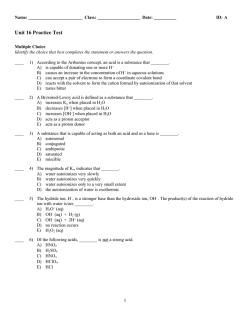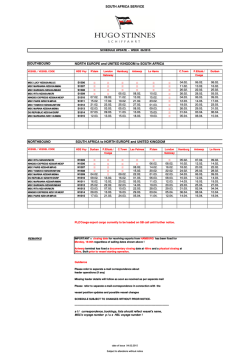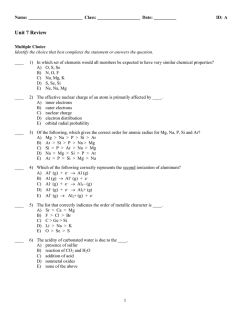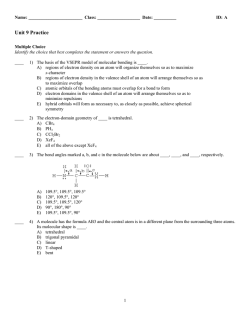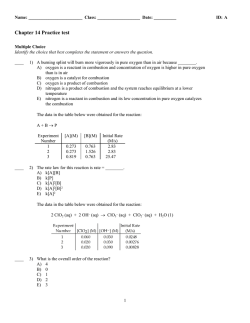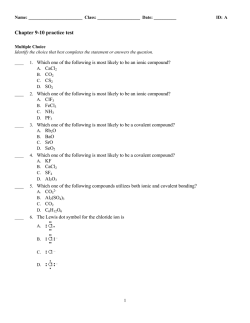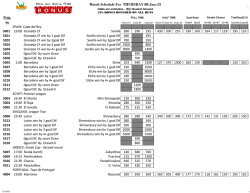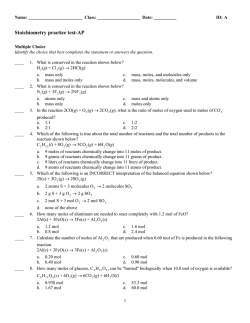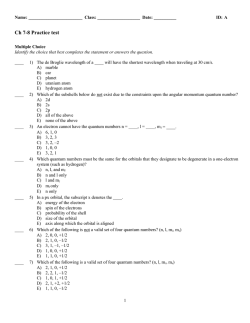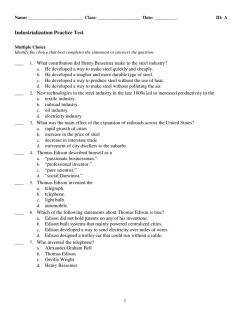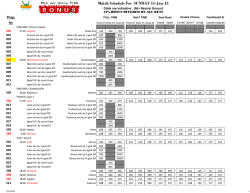
Sample-Exam-3
NAME: __________________________ Fall 2013 -- Astronomy 1010: Planetary Astronomy Exam 3 – Chapters 5, 6, & 7 Circle your answer clearly AND print the CAPITAL LETTER to the left of the question. There are 30 multiple choice (3 pts. each) and 1 discussion (10 pts. each) question. Good luck. Multiple Choice Identify the choice that best completes the statement or answers the question. ____ 1. The speed of light was first determined by which scientist? a. Galileo b. Newton c. Kepler d. Rømer e. Einstein ____ 2. The speed of light in a vacuum is: a. 300,000 m/s b. 300,000 mph c. 300,000 km/s d. 300,000,000 mph e. infinite ____ 3. If the Sun instantaneously stopped giving off light, what would happen on Earth? a. It would immediately get dark. b. It would get dark 8 minutes later. c. It would get dark 27 minutes later. d. It would get dark 1 hour later. e. It would get dark 24 hours later. ____ 4. What is the difference between visible light and X-rays? a. Speed; X-rays go faster than visible light. b. Speed; X-rays go slower than visible light. c. Wavelength; X-rays have a shorter wavelength than visible light. d. Wavelength; X-rays have a longer wavelength than visible light. e. X-rays are made up of particles, while visible light is made up of waves. ____ 5. How does the speed of light traveling through a medium (such as air or glass) compare to the speed of light in a vacuum? a. It is the same as the speed of light in a vacuum. b. It is always less than the speed of light in a vacuum. c. It is always greater than the speed of light in a vacuum. d. Sometimes it is greater than the speed of light in a vacuum, and sometimes it is less, depending on the medium. e. Light can’t travel through a medium, it only can go through a vacuum. ____ 6. Use the figure below to answer the following question: Which of these statements about the amplitude and wavelength of the two waves shown is correct? a. Wave A has a larger amplitude and a larger wavelength. b. Wave B has a larger amplitude and a larger wavelength. c. Wave A has a larger amplitude, and Wave B has a larger wavelength. d. Wave B has a larger amplitude, and Wave A has a larger wavelength. e. Wave A and B have the same amplitude and wavelength. ____ 7. Which of the following lists different types of electromagnetic radiation in order from the smallest wavelength to the largest wavelength? a. radio waves, infrared, visible, ultraviolet, X-rays b. gamma rays, ultraviolet, visible, infrared, radio waves c. gamma rays, X-rays, infrared, visible, ultraviolet d. X-rays, infrared, visible, ultraviolet, radio waves e. radio waves, ultraviolet, visible, infrared, gamma rays ____ 8. Saying that something is quantized means that it: a. is a wave b. is a particle c. travels at the speed of light d. can only have discrete quantities e. is smaller than an atom ____ 9. In the quantum mechanical view of the atom, an electron is best thought of as: a. a cloud that is centered on the nucleus b. a particle orbiting the nucleus c. free to orbit at any distance from the nucleus d. a particle inside the nucleus e. All of the above are true. ____ 10. The Doppler shift can be used to determine the _________ of an object. a. energy b. temperature c. radial velocity d. color e. three-dimensional velocity ____ 11. The Kelvin temperature scale is used in astronomy because: a. at 0 K an object has absolutely zero energy b. water freezes at 0 K c. water boils at 100 K d. hydrogen freezes at 0 K e. the highest temperature possible is 1000 K ____ 12. As a blackbody becomes hotter, it also becomes _________ and _________. a. more luminous; redder b. more luminous; bluer c. less luminous; redder d. less luminous; bluer e. more luminous; stays the same color ____ 13. The telescope was invented by: a. Galileo Galilei, an Italian inventor b. Hans Lippershey, an eyeglass maker in the Netherlands c. Gote Reber, a German cabinetmaker d. Tycho Brahe, a Danish astronomer e. Johannes Kepler, a German astronomer ____ 14. The magnification of a telescope depends on the focal length of the telescope and: a. the size of the aperture b. the type of telescope (refracting vs. reflecting) c. the wavelengths being observed d. the focal length of the eyepiece e. the angular resolution of the telescope ____ 15. The aperture of a telescope partially or totally determines its: a. focal length and magnification b. light-gathering power c. focal length d. light-gathering power and magnification e. light-gathering power and diffraction limit ____ 16. Which telescope would collect 100 times more light than a 1-meter telescope? a. 100-meter telescope b. 80-meter telescope c. 50-meter telescope d. 30-meter telescope e. 10-meter telescope ____ 17. A prism is able to spread white light out into a spectrum of colors based on the property of: a. reflection b. refraction c. magnification d. resolution e. aberration ____ 18. Which of the following phenomena is shown in the figure below? a. b. c. d. e. reflection chromatic aberration diffraction magnification interference ____ 19. The major advantage CCDs have over other imaging techniques is that: a. they have a higher quantum efficiency b. they have a linear response to light c. they yield output in digital format d. they operate at visible and near-infrared wavelengths e. All of the above are true. ____ 20. Astronomers can use ground-based telescopes to observe in the majority of which of the following parts of the electromagnetic spectrum? a. visible and infrared b. visible and ultraviolet c. visible and radio d. visible, ultraviolet, and infrared e. visible, infrared, and radio ____ 21. What type of waves have NOT yet been directly detected by astronomers? a. sound waves b. gravitational waves c. X-ray waves d. gamma-ray waves e. pressure waves ____ 22. According to the conservation of angular momentum, if an ice skater starts spinning with her arms out wide, then slowly pulls them close to her body, this will cause her to: a. spin faster c. maintain a constant rate of spin b. spin slower d. fall down ____ 23. What happens to the kinetic energy of gas as it falls toward and eventually hits the accretion disk surrounding a protostar? a. It is immediately converted into photons, giving off a flash of light upon impact. b. It is converted into thermal energy, heating the disk. c. It is converted into potential energy as the gas plows through the disk and comes out the other side. d. It becomes the kinetic energy of the orbit of the gas in the accretion disk around the protostar. e. It disappears into interstellar space. ____ 24. The primary atmospheres of the planets are made mostly of: a. carbon and oxygen b. hydrogen and helium c. oxygen and nitrogen d. iron and nickel e. nitrogen and argon ____ 25. Comets and asteroids are: a. other names for moons of the planets b. primarily located within 1 AU of the Sun c. all more massive than Earth’s Moon d. material left over from the formation of the planets e. other names for meteors ____ 26. Why have astronomers using the radial velocity method found more Jupiter-sized planets at a distance of 1 AU around other stars than Earth-sized planets? a. A Jupiter-sized planet occults a larger area than an Earth-sized planet. b. A Jupiter-sized planet exerts a larger gravitational force on the star than an Earth-sized planet, and the Doppler shift of the star is larger. c. A Jupiter-sized planet shines brighter than an Earth-sized planet. d. Earth-sized planets are much rarer than Jupiter-sized planets. e. Actually, the planets found at these distances have all been Earth sized. ____ 27. An observer located outside our Solar System, who monitors the velocity of our Sun over time, will find that its velocity varies by 12 m/s over a period of 12 years, because of: a. Jupiter’s gravitational pull b. Earth’s gravitational pull c. variations in its brightness d. convection on the Sun’s surface e. the sunspot cycle ____ 28. The borderline between the most massive planet and the least massive brown dwarf occurs at: a. 4 Jupiter masses b. 13 Jupiter masses c. 120 Jupiter masses d. 80 Jupiter masses e. 45 Jupiter masses ____ 29. The Kepler mission is designed to search for extrasolar planets using the _________ method. a. Doppler shift c. microlensing b. transit d. direct imaging ____ 30. Consider a star that is more massive and hotter than the Sun. For such a star, the habitable zone would: a. be located inside 1 AU c. not exist at any radii b. be located outside 1AU d. exist at every radii Short Answer Explain the two primary reasons why the inner solar nebula was hotter than the outer solar nebula. How does this help astronomers explain the basic difference in composition between the inner planets and the outer planets? ASTR-1010_Fall_2013_Ex-3 Answer Section MULTIPLE CHOICE 1. ANS: TOP: 2. ANS: TOP: 3. ANS: TOP: 4. ANS: TOP: 5. ANS: TOP: 6. ANS: TOP: 7. ANS: TOP: 8. ANS: TOP: 9. ANS: TOP: 10. ANS: TOP: 11. ANS: TOP: 12. ANS: TOP: 13. ANS: TOP: 14. ANS: TOP: 15. ANS: TOP: 16. ANS: TOP: 17. ANS: TOP: 18. ANS: TOP: 19. ANS: TOP: 20. ANS: TOP: D PTS: 1 1IIi MSC: Factual C PTS: 1 1IIii MSC: Factual B PTS: 1 1IIii MSC: Applied C PTS: 1 1IIii | 2IIIi | 2IVi B PTS: 1 1IIiii MSC: Factual D PTS: 1 2IIi MSC: Applied B PTS: 1 2IIiii MSC: Factual D PTS: 1 2IVii MSC: Factual A PTS: 1 3Iiv MSC: Conceptual C PTS: 1 4Iii MSC: Factual A PTS: 1 5IIi MSC: Factual B PTS: 1 5IVi | 5Vi MSC: Factual B PTS: 1 1Iii MSC: Factual D PTS: 1 1IIii MSC: Factual E PTS: 1 1IIii | 1IIiii | 1Vii E PTS: 1 1IIiii MSC: Applied B PTS: 1 1IIIii MSC: Conceptual B PTS: 1 1IIIii MSC: Applied E PTS: 1 2IIIi | 2IIIii | 2IIIiii | 2IIIiv | 2IIIv C PTS: 1 3Ii | 3Iii MSC: Factual DIF: Easy REF: Section 5.1 DIF: Easy REF: Section 5.1 DIF: Medium REF: Section 5.1 DIF: Easy MSC: Conceptual DIF: Easy REF: Section 5.2 DIF: Easy REF: Section 5.2 DIF: Medium REF: Section 5.2 DIF: Medium REF: Section 5.2 DIF: Medium REF: Section 5.3 DIF: Easy REF: Section 5.4 DIF: Easy REF: Section 5.5 DIF: Medium REF: Section 5.5 DIF: Easy REF: Section 6.1 DIF: Easy REF: Section 6.1 DIF: Medium MSC: Factual DIF: Medium REF: Section 6.1 DIF: Medium REF: Section 6.1 DIF: Medium REF: Section 6.1 DIF: Easy MSC: Applied DIF: Easy REF: Section 6.2 REF: Section 5.1 REF: Section 6.1 REF: Section 6.3 21. ANS: TOP: 22. ANS: TOP: 23. ANS: TOP: 24. ANS: TOP: 25. ANS: TOP: 26. ANS: TOP: 27. ANS: TOP: 28. ANS: TOP: 29. ANS: TOP: 30. ANS: TOP: B 6Iiii A 2IIi B 3Iii B 3IIi D 4Ivii B 5IIi A 5IIii B 5IIIvi B 6Ii B 6Iiv PTS: MSC: PTS: MSC: PTS: MSC: PTS: MSC: PTS: MSC: PTS: MSC: PTS: MSC: PTS: MSC: PTS: MSC: PTS: MSC: 1 Factual 1 Conceptual 1 Applied 1 Factual 1 Factual 1 Conceptual 1 Conceptual 1 Factual 1 Factual 1 Applied DIF: Easy REF: Section 6.6 DIF: Easy REF: Section 7.2 DIF: Medium REF: Section 7.3 DIF: Easy REF: Section 7.3 DIF: Easy REF: Section 7.4 DIF: Medium REF: Section 7.5 DIF: Medium REF: Section 7.5 DIF: Medium REF: Section 7.5 DIF: Easy REF: Section 7.6 DIF: Easy REF: Section 7.6 SHORT ANSWER 1. ANS: The inner solar nebula was hotter than the outer solar nebula because the inner regions converted more of their potential energy into kinetic energy and heat when the original cloud collapsed to form the Solar System. In addition, when the Sun began to shine, it heated the inner Solar System more than the outer Solar System. PTS: 1 DIF: Medium REF: Section 7.3 TOP: 3Iv MSC: Conceptual 2. ANS: The inner planets (Mercury, Venus, Earth, and Mars) formed in the region of the Solar System where only refractory materials could exist in solid form, and therefore they are composed mostly of rocks and metals. The outer planets (Jupiter, Saturn, Uranus, and Neptune) formed out where even volatile materials could exist in solid form. As a result, in addition to rocks and metals, the Jovian planets and their moons are largely composed of ices as well. The solar wind reinforced these differences by clearing the inner Solar System of light gases during the planetary formation process. PTS: 1 MSC: Conceptual DIF: Medium REF: Section 7.4 TOP: 4Iii
© Copyright 2026
